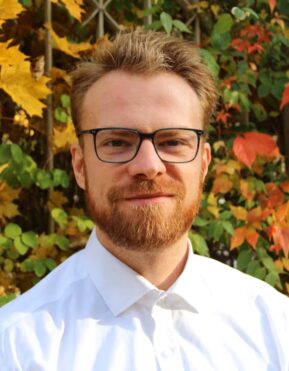505. JENAer Optikkolloquium · Prof. Dr. Christian Franke

Seit Mai 2018 findet das traditionelle JENAer Carl-Zeiss-Optikkolloquium als JENAer Optikkolloquium am Abbe Center of Photonics auf dem Beutenberg Campus Jena und online statt. Es ist offen für alle Interessierten aus Forschung, Wirtschaft und Bildung und versteht sich als Forum für neue Technologien rund um die Photonik.
EINWAHLLINK: https://optonet-jena-de.zoom.us/j/83007812213
Zur 505. Ausgabe des Kolloquiums freuen wir uns auf Prof. Dr. Christian Franke und seinen Vortrag
FROM CENTIMETERS TO NANOMETERS: NOVEL OPtICAL TOOLS FOR QUANTITATIVE MULTI-MODAL IMAGING
Early symptoms of many neurodegenerative diseases can be subtle and nonspecific, making them difficult to identify in the prodromal stages. Their early detection and diagnosis, however, is crucial for effective interventions to prevent rapid disease progression and promote better health outcomes. However, current methods for early detection and diagnosis of neurological diseases have limited accuracy, specificity, and reliability.
For example, many diagnostic criteria for neurodegenerative diseases are based on subjective cognitive and behavioral assessments, such as cognitive/memory tests and rating scales.Despite significant progress in understanding the pathophysiology of different neurodegenerative syndromes and their genetic risk factors, the molecular mechanisms that drive the onset of these diseases often remain unclear. Moreover, the lack of specific and sensitive (molecular) biomarkers for these diseases makes it challenging to accurately diagnose early stages.
Hereditary spastic paraplegia (HSP), for instance, is a prototype of a genetically very diverse group of neurological disorders that share the degeneration of axons of cortical motoneurons thus leading to progressive spasticity, weakness, and muscle atrophy.
For many neurological disorders, subtle changes in posture, facial geometry and symmetry, i.e. macroscopic phenotypes, coincide with progressive alterations in the molecular machinery of cells and the nanoscale geometry and organization of subcellular organelles and proteins. For example, neurons are highly specialized cells with specific requirements for structural and functional subdomains that maintain polarity, extend and repair their axonal and dendritic protrusions, and organize sites for synaptic transmission, which can already be distorted at early onsets of neurodegenerative disorders. Distortions involve all parts of the cell from the plasma membrane over the cytoskeleton to intracellular organelles such as the endoplasmic reticulum (ER) and the endo-lysosomal/vesicular system.
Here we present our latest efforts to combine nanoscale super-resolution imaging with structured light stereophotogrammetry to investigate neurological disorders across 9 orders of spatial scale in the future.
Prof. Dr. Christian Franke

From 2006–2012, Professor Franke studied physics at the University of Würzburg. Afterwards, he joined the group of Prof. Markus Sauer at the Biocenter Würzburg to do his PhD work in methods development for quantitative super-resolution microscopy. In 2017 he finished his PhD work and started his Postdoctoral research in applied super-resolution microscopy at the Max Planck Institute of Molecular Cell Biology and Genetics Dresden in the department of Prof. Dr. Marino Zerial.
In November 2020 he started his own Lab as an Assistant Professor of Digitized Experimental Microscopy at the Institute of Applied Optics and Biophysics (IAOB) of the Friedrich Schiller University Jena.
Teilnahme und Buchungskonditionen
- Die Veranstaltung ist offen für alle Interessierten und kann ab sofort gebucht werden.
- Die Teilnahme ist kostenfrei.
- Der Einwahllink wird am Veranstaltungstag gegen 15 Uhr an die angemeldeten Teilnehmer:innen verschickt und parallel dazu auf dieser Seite veröffentlicht.
- Der Vortrag wird in englischer Sprache gehalten.
Das JENAer Optikkolloquium wird unterstützt von: Carl Zeiss AG · Ernst-Abbe-Hochschule Jena · Fraunhofer-Institut für Angewandte Optik und Feinmechanik · Friedrich-Schiller-Universität Jena · JENOPTIK AG · Leibniz-Institut für Photonische Technologien e.V.
Veranstalter ist OptoNet e.V.
Historie
Das JENAer Optikkolloquium geht auf eine Veranstaltungsreihe der Jenaer Zeiss-Werke zurück, die 1971 zunächst zur Weiterbildung der Mitarbeiter:innen ins Leben gerufen wurde. Durch die Gewinnung hochkarätiger Referent:innen entwickelte es sich schnell zu einem wichtigen Diskussionsforum der führenden Optikexperten des Landes.
Nach 1989 wurde das Kolloquium in Zusammenarbeit mit dem Institut für Angewandte Optik der Universität Jena, vertreten durch Prof. Kowarschik, weitergeführt und gewann durch die Beteiligung führender Wissenschaftler und Unternehmen und die Kooperation u.a. mit dem Fraunhofer IOF und dem Leibniz IPHT weiter an Bedeutung.
Hinweis
Mit Absendung dieses Anmeldeformulars stimmen Sie zu, dass Ihr Name auf einer Teilnehmerliste geführt wird, die den übrigen Teilnehmer:innen zur Verfügung steht. Darüber hinaus sind Sie einverstanden, dass Bilder der Veranstaltung auf unseren Webseiten und unseren Social Media Accounts gezeigt werden können, sofern Sie nicht vor der Veranstaltung ausdrücklich widersprechen.
Veranstaltungsform
Veranstaltungsort
Abbe Center of Photonics
Albert-Einstein-Straße 6
07745 Jena
Deutschland
Kontakt
OptoNet e.V.
Svenja Hübner
03641–327 92 94
ed.muiuqollokkitpo@ofni
www.optonet-jena.de
Diese Veranstaltung buchen
Buchungen sind für diese Veranstaltung nicht mehr möglich.